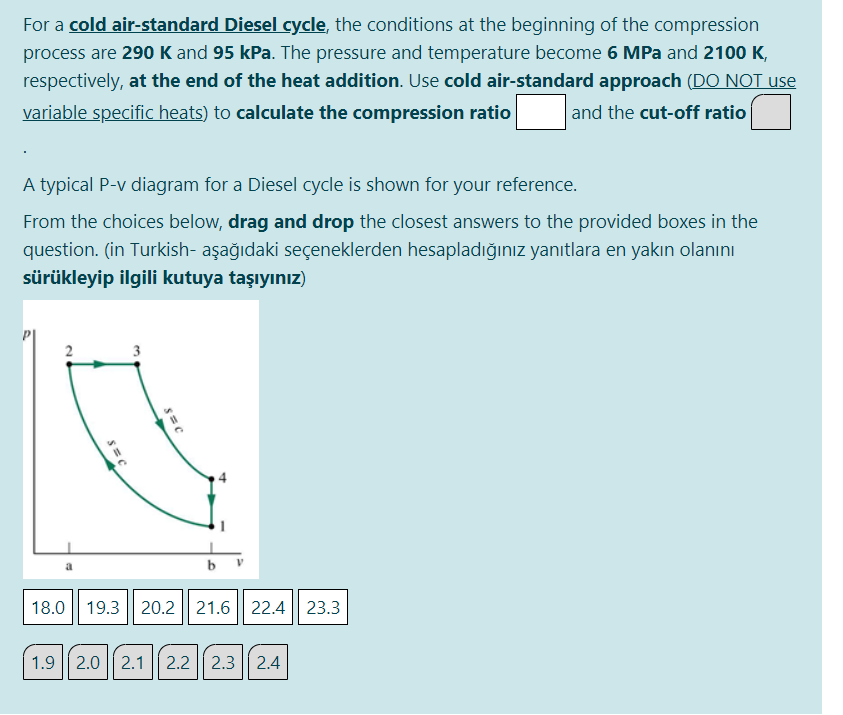For a cold air-standard Diesel cycle, the conditions at the beginning of the compression process are 290 K and 95 kPa. The pressure and temperature become 6 MPa and 2100 K, respectively, at the end of the heat addition. Use cold air-standard approach (DO NOT use variable specific heats) to calculate the compression ratio and the cut-off ratio
For a cold air-standard Diesel cycle, the conditions at the beginning of the compression process are 290 K and 95 kPa. The pressure and temperature become 6 MPa and 2100 K, respectively, at the end of the heat addition. Use cold air-standard approach (DO NOT use variable specific heats) to calculate the compression ratio and the cut-off ratio
Elements Of Electromagnetics
7th Edition
ISBN:9780190698614
Author:Sadiku, Matthew N. O.
Publisher:Sadiku, Matthew N. O.
ChapterMA: Math Assessment
Section: Chapter Questions
Problem 1.1MA
Related questions
Question
May I get help with this question please?

Transcribed Image Text:For a cold air-standard Diesel cycle, the conditions at the beginning of the compression
process are 290 K and 95 kPa. The pressure and temperature become 6 MPa and 2100 K,
respectively, at the end of the heat addition. Use cold air-standard approach (DO NOT use
variable specific heats) to calculate the compression ratio
and the cut-off ratio
A typical P-v diagram for a Diesel cycle is shown for your reference.
From the choices below, drag and drop the closest answers to the provided boxes in the
question. (in Turkish- aşağıdaki seçeneklerden hesapladığınız yanıtlara en yakın olanını
sürükleyip ilgili kutuya taşıyınız)
2
3
18.0 || 19.3 || 20.2 21.6 || 22.4 23.3
1.9
2.0 || 2.1
2.2
2.3 | 2.4
Expert Solution
This question has been solved!
Explore an expertly crafted, step-by-step solution for a thorough understanding of key concepts.
This is a popular solution!
Trending now
This is a popular solution!
Step by step
Solved in 3 steps

Knowledge Booster
Learn more about
Need a deep-dive on the concept behind this application? Look no further. Learn more about this topic, mechanical-engineering and related others by exploring similar questions and additional content below.Recommended textbooks for you

Elements Of Electromagnetics
Mechanical Engineering
ISBN:
9780190698614
Author:
Sadiku, Matthew N. O.
Publisher:
Oxford University Press

Mechanics of Materials (10th Edition)
Mechanical Engineering
ISBN:
9780134319650
Author:
Russell C. Hibbeler
Publisher:
PEARSON

Thermodynamics: An Engineering Approach
Mechanical Engineering
ISBN:
9781259822674
Author:
Yunus A. Cengel Dr., Michael A. Boles
Publisher:
McGraw-Hill Education

Elements Of Electromagnetics
Mechanical Engineering
ISBN:
9780190698614
Author:
Sadiku, Matthew N. O.
Publisher:
Oxford University Press

Mechanics of Materials (10th Edition)
Mechanical Engineering
ISBN:
9780134319650
Author:
Russell C. Hibbeler
Publisher:
PEARSON

Thermodynamics: An Engineering Approach
Mechanical Engineering
ISBN:
9781259822674
Author:
Yunus A. Cengel Dr., Michael A. Boles
Publisher:
McGraw-Hill Education

Control Systems Engineering
Mechanical Engineering
ISBN:
9781118170519
Author:
Norman S. Nise
Publisher:
WILEY

Mechanics of Materials (MindTap Course List)
Mechanical Engineering
ISBN:
9781337093347
Author:
Barry J. Goodno, James M. Gere
Publisher:
Cengage Learning

Engineering Mechanics: Statics
Mechanical Engineering
ISBN:
9781118807330
Author:
James L. Meriam, L. G. Kraige, J. N. Bolton
Publisher:
WILEY